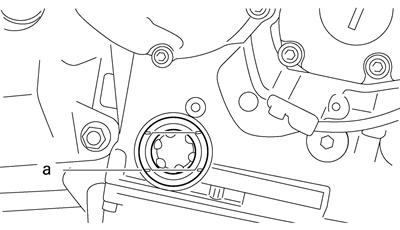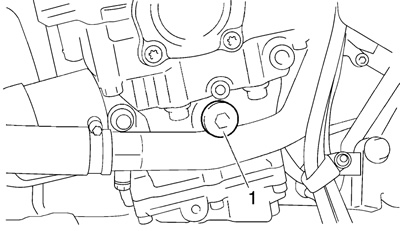- Engine oil level
Below the minimum level mark "a" → Add the recommended engine oil to the proper level.

2. Start the engine, warm it up for several minutes, and then turn it off.
Caution! When the engine is cold, the engine oil will have a higher viscosity, causing the engine oil pressure to increase. Therefore, be sure to measure the engine oil pressure after warming up the engine.
3. Remove:
- Oil gallery bolt "1"
Warning! The engine, muffler and engine oil are extremely hot.

4. Install:
- Oil pressure gauge "1"
- Adapter "2"
Pressure gauge — 90890-03153 YU-03153
Oil pressure adapter — H 90890-03139

5. Measure:
- Engine oil pressure (at the following conditions)
Engine oil pressure — 230 kPa (2.3 kg/cm2, 2.3 bar, 32.71 psi)
Engine speed — Approx. 5,000 r/min
Engine oil temperature — 100°C (212°F)
Note: Regarding the oil pressure as its own data may fluctuate depending on the oil temperature and viscosity, the oil pressure may fluctuate when measuring. The following data should be used only as a reference when measuring the engine oil pressure.
| Engine oil pressure | Possible causes |
| Below specification | • Faulty oil pump • Clogged oil filter • Leaking oil passage • Broken or damaged oil seal |
| Above specification | • Leaking oil passage • Faulty oil filter • Oil viscosity too high |
6. Install:
- Oil gallery bolt "1"
Oil gallery bolt — 8 Nm (0.8 m·kg, 5.8 ft·lb)
Caution! Be careful to tighten too much.

